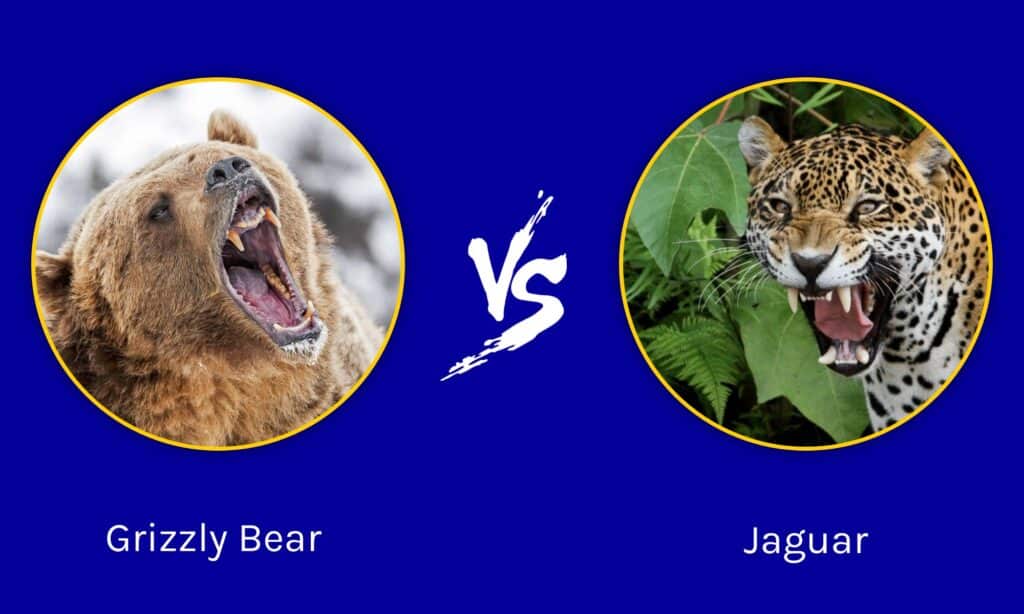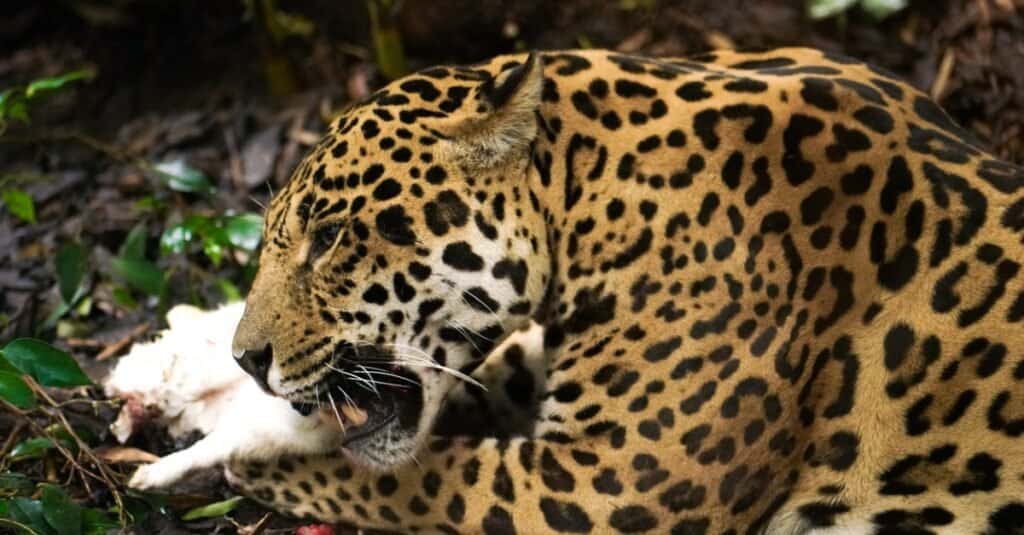Grizzly bears are large, powerful, and deadly animals when they choose to act as predators. Few animals can resist them as prey, and nothing in their range serves as a true predator for them. However, jaguars are lithe cats that can strike down prey that’s much larger than them using ambush tactics. Also, at least one jaguar has been found killing a black bear. So, how would a grizzly bear vs jaguar battle play out?
We’re going to examine a battle between these two beasts and show you which of them is most likely to survive!
Comparing a Grizzly Bear and a Jaguar

| Grizzly Bear | Jaguar | |
|---|---|---|
| Size | Weight: from 400 to 700 pounds, up to 1,200 pounds Length: between 7 and 10 feet at their very longest Height: usually 3 to 3.5 feet, but can measure 4.5 feet tall | Weight: from 120 to 350 pounds Height: 2 to 2.5 feet at the shoulder Length: between 3.5 and 5.5 feet |
| Speed | – Capable of running up to 35 mph | – Runs at speeds of 40 to 50 mph |
| Defenses | – Its speed allows the bear to run away from trouble – Physical power makes this bear hard to pin or physically dominate – Has a fat layer that can be several inches thick – Thick skin and dense fur provide a protective outer layer | – Speed allows it to get away from trouble – Can climb trees to stay out of harm’s way – Capable swimmer |
| Offensive Capabilities | – Massive bite power of 975 PSI – 3-inch-long fangs and 1-inch teeth – Has claws that measure up to 5 inches long for slashing prey – Immense physical strength along with large paws allows for a strong smashing attack – Powerful bite and shaking can disorient and ravage prey | – Has a bite power that reaches 1,500 PSI – 2-inch fangs with 30 teeth – Has sharp claws, but they’re only 2 inches long – Often kills prey by biting the back of its skull – Unlike other big cats, it doesn’t try strangling prey |
| Predatory Behavior | – Mostly a gatherer and scavenger – An opportunist that pursues prey, looking for the right spot and moment to strike | – Ambush predator that can attack from the grass or even initiate an attack from a tree |
What Are The Key Differences Between a Grizzly Bear and a Jaguar?
The most important differences between a grizzly bear and a jaguar can be found in their size and attack methods. Grizzly bears are large quadrupedal predators that weigh up to 1,200 pounds and stand between 3.5 and 4.5 feet tall at their utmost. They are opportunistic hunters that use a combination of mauling attacks to kill their prey. Meanwhile, jaguars are sizeable cats that weigh up to 350 pounds and stand 2 to 2.5 feet tall, and they use an ambush attack to bite the base of their prey’s skull to kill them.
These are two major differences between the animals, but they are not the only ones that exist. Other factors will play a large role in how the fight plays out.
What Are the Key Factors in a Fight Between a Grizzly Bear and a Jaguar?
The most significant factors in the fight between a grizzly bear and a jaguar include their size, defenses, and attack methods. We’re going to explore all three of these key factors along with two others. By examining each of them closely, we can determine which animal has an advantage in a given area.
With enough of that data, we can safely say which creature is most likely to walk away from this fight.
Grizzly Bear vs. Jaguar: Size

Grizzly bears are larger than jaguars.
©Jack Nevitt/Shutterstock.com
Jaguars are large cats, but they’re not as large as grizzly bears. Grizzly bears are massive mammals that can weigh between 400 and 700 pounds with a maximum weight of over 1,000 pounds. They can stand between 3 and 3.5 feet on average, but they can also stand up to 4.5 feet tall. Moreover, they can grow between 7 and 10 feet long, but the latter length is very rare.
A jaguar can measure between 3.5 and 5.5 feet long while standing up to 2.5 feet tall. They weigh between 120 and 300 pounds on average.
The grizzly bear has a size advantage against the jaguar.
Grizzly Bear vs. Jaguar: Speed and Movement
Jaguars are far faster than grizzly bears. Grizzly bears are fast, reaching a maximum running speed of 35 mph. Meanwhile, jaguars can run at speeds between 40 and 50 mph.
The jaguar has a speed advantage in this fight.
Grizzly Bear vs. Jaguar: Defenses
One reason that most predators don’t bother attacking grizzly bears is that they are so large and, quite simply, hard to harm. Bears have fur, thick skin, and layers of fat that prevent them from coming to harm from anything short of a pack of wolves or a larger animal. Their bones are tough, their skulls are thick, and they’re capable of running away from trouble if a group of animals turns the tables on them.
Jaguars rely on their speed and stealth to stay safe. They can climb into trees to stay out of trouble, and they can use their fur coloration as a limited form of camouflage in their natural environment. Still, jaguars don’t carry much extra weight to soak up attacks, though. They count on being the aggressor and winner of every fight they’re in.
The grizzly bear has a defensive advantage in this battle.
Grizzly Bear vs. Jaguar: Offensive Capabilities
Jaguars have a powerful method of attacking prey. They have 2-inch-long fangs, 30 teeth, and a bite power that could be as high as 1,500 PSI. That’s even stronger than a grizzly bear’s bite strength at 975 PSI.
They also utilize their sharp, 2-inch claws to grasp their prey. However, their main attack comes from an ambush. Jaguars attack their prey by biting the base of their skull, instantly causing significant, often fatal damage. That’s in contrast to most large cats that try to strangle their prey.
Grizzly bears have an incredibly potent attack that uses bites, clawing, shaking, and even their body weight to wear down and kill their prey. They don’t have a single fatal attack like the jaguar, but they can use a flurry of bites from 3-inch fangs and 5-inch claws to ravage their foes. Their fatal blows often land around the neck and back, lacking the extreme precision of big cats.
Grizzly bears have a multi-faceted attack, but the competence of the jaguar makes this a tie.
Grizzly Bear vs. Jaguar: Predatory Behavior

The jaguar has more predatory instincts than the grizzly bear.
©iStock.com/Steven Anderton
Jaguars are ambush predators. They stalk their prey from dense vegetation or a higher position, sometimes trees. Grizzly bears are opportunists that locate and chase down their prey. They can surprise prey and use their speed to attack them before they know what’s happening. Still, they aren’t as precise as true ambush predators.
Jaguars have the advantage of predatory behaviors.
Who Would Win in a Fight Between a Grizzly Bear and a Jaguar?

A grizzly bear would win a battle against a jaguar.
©Scott E Read/Shutterstock.com
A grizzly bear would win a fight against a jaguar. The jaguar lacks the methods of attack to bring down a grizzly bear. Even if the fight started from an ambush, we’re not confident that the big cat is going to bite through all the layers of fur, flesh, and fat to deliver a fatal, crushing blow to a grizzly bear’s large head.
Instead, the jaguar would certainly land an attack and draw blood. The creature would inadvertently solve the biggest problem that a grizzly would have— getting close to the big cat. The grizzly would turn the tables, pinning the jaguar and setting about its vicious attack. It could bite the cat’s back and neck while it tries to run away.
Unfortunately, the jaguar doesn’t have layers of flesh and fat to cushion those blows. The grizzly crunches down on the vertebrate and skull of the jaguar, smacks it around, and finishes the job. Jaguars like “El Jefe” may be able to take down a black bear, but they don’t stand a chance against a grizzly.
Up Next:
- Watch a Grizzly Ambush Three Moose in Denali
- Watch a Rampaging Grizzly Attack a Group of Elk in Yellowstone
- Epic Battles: Grizzly Bear vs. Rhino
- Watch an Adult Grizzly Charge a Park Ranger in Yellowstone
- Epic Battles: Grizzly Bear vs. A Pack of Honey Badgers
The photo featured at the top of this post is © Volodymyr Burdiak/Shutterstock.com
Sources
- Rain Forest Alliance (1970) rainforest-alliance.org/species/jaguar/#:~:text=Jaguars spend much of their,to hunt or to rest
Thank you for reading! Have some feedback for us? Contact the AZ Animals editorial team.






